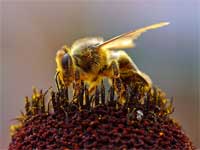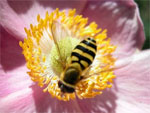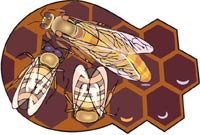|

Bees have a long tube-like proboscis that enables them to obtain
the nectar from flowers. Bees have antennae made up of thirteen
segments in males and twelve in females. They have two pairs of
wings, the back pair being the smaller of the two.

 Important pollinators : Bees may focus on gathering nectar or on gathering pollen, depending
on their greater need at the time. Bees gathering nectar may accomplish
pollination, but bees that are deliberately gathering pollen are
more efficient pollinators. It is estimated that one third of the
human food supply depends on insect pollination, most of this accomplished
by bees. Important pollinators : Bees may focus on gathering nectar or on gathering pollen, depending
on their greater need at the time. Bees gathering nectar may accomplish
pollination, but bees that are deliberately gathering pollen are
more efficient pollinators. It is estimated that one third of the
human food supply depends on insect pollination, most of this accomplished
by bees.
Basket legs: Bees are fuzzy and carry an electrostatic charge, thus aiding in
the adherence of pollen. They periodically stop foraging and groom
themselves to pack the pollen into specialized pollen baskets which
are on the legs of honeybees and some other species, and on the
ventral abdomen on other species.

Mission - "Pollen": Visiting flowers is a dangerous occupation, with very high mortality
rates. Many assassin bugs and crab spiders hide in flowers to capture unwary bees. Others are lost to birds in flight. Insecticides used
on blooming plants can kill large numbers of bees, both by direct
poisoning and by contaminating their food supply. A honeybee queen
may lay 2000 eggs per day during spring buildup, but she also must
lay 1000 to 1500 eggs per day during the foraging season, simply
to replace daily casualties.
Sting like a bee: In honeybees, the worker bees have a modified ovipositor called a stinger with which they can sting to defend the hive. Contrary to popular belief, the bee will not always die soon after stinging: this is a misconception based on the fact that a bee will always die shortly after stinging a mammal; however, the stinger evolved primarily for inter-bee combat.
Members of the hive
Worker bees are infertile females, however in some circumstances
they may lay infertile eggs. Worker bees secrete the wax used to
build the hive, clean and maintain the hive, raise the young, guard
the hive and forage for nectar and pollen.
 Live to love: Drone bees are the male bees of the colony. Since they do not have
ovipositors, they also do not have stingers. Drone honeybees do
not forage for nectar or pollen. In some species, drones are suspected
of playing a contributing role in the temperature regulation of
the hive. The primary purpose of a drone bee is to fertilize a new
queen. Drones mate with the queen in flight, then die immediately
after mating. Live to love: Drone bees are the male bees of the colony. Since they do not have
ovipositors, they also do not have stingers. Drone honeybees do
not forage for nectar or pollen. In some species, drones are suspected
of playing a contributing role in the temperature regulation of
the hive. The primary purpose of a drone bee is to fertilize a new
queen. Drones mate with the queen in flight, then die immediately
after mating.
Long live the Queen!: Queens live for up to three years, while workers have an average
life of only three months (during the foraging season, but longer
in places with extended winters).
Cool in the heat: When a hive detects smoke, many bees become remarkably non aggressive.
It is speculated that this is a defense mechanism; wild colonies
generally live in hollow trees, and when bees detect smoke it is
presumed that they prepare to evacuate from a forest fire, carrying
as much food reserve as they can. In this state, defense from predation
is relatively unimportant; saving as much as possible is the most
important activity.

The larvae and pupae in a frame of honeycomb are referred to as frames of brood and are often sold (with adhering bees) by beekeepers to other beekeepers to start new beehives.
 Breakfast fit for a queen: Both workers and queens are fed royal jelly during the first three days of the larval stage, then workers are switched to a diet of pollen and nectar or diluted honey, while those intended for queens will continue to receive royal jelly. This causes the larva to develop to the pupa stage more quickly, while being also larger and fully developed sexually. Breakfast fit for a queen: Both workers and queens are fed royal jelly during the first three days of the larval stage, then workers are switched to a diet of pollen and nectar or diluted honey, while those intended for queens will continue to receive royal jelly. This causes the larva to develop to the pupa stage more quickly, while being also larger and fully developed sexually.
The fall of the throne: Periodically, the colony determines that a new queen is needed.
There are three general triggers:
- The colony becomes space-constrained because the hive is filled
with honey, leaving little room for new eggs. This will trigger
a swarm where the old queen will take about half the worker bees
to found a new colony, leaving the new queen with the other half
of worker bees to continue the old colony.
- The old queen begins to fail. This is thought to be recognized
by a decrease in queen pheromones throughout the hive. This situation
is called supersedure. At the end of the supersedure, the old
queen is generally killed.
- The old queen dies suddenly. This is an emergency supersedure.
The worker bees will find several eggs or larvae in the right
age-range and attempt to develop them into queens. Emergency supersedure
can generally be recognized because the queen cell is built out
from a regular cell of the comb rather than hanging from the bottom
of a frame.
Regardless of the trigger, the workers develop the larvae into
queens by continuing to feed them royal jelly. This triggers an
extended development as a pupa.
Killer Queen: When the virgin queen emerges, she is commonly thought to seek
out other queen cells and sting the infant queens within and that
should two queens emerge simultaneously, they will fight to the
death. Recent studies, however, have indicated that colonies may
maintain two queens in as many as 10% of hives. The mechanism by
which this occurs is not yet known. Regardless, the queen asserts
her control over the worker bees through the release of a complex
suite of pheromones called queen scent.
Husbands in the air: After several days of orientation within and around the hive, the
young queen flies to a drone congregation point - a site near a
clearing and generally about 30 feet above the ground where the
drones from different hives tend to congregate. Drones find the
queen by sight and mate with her in midair. After mating, the drone
dies.  A queen will mate multiple times and may return several days
in a row, weather permitting, until her spermathrecea is full. A queen will mate multiple times and may return several days
in a row, weather permitting, until her spermathrecea is full.
The queen lays all the eggs in a healthy colony. The number and
pace of egg-laying is controlled by weather and availability of
resources and by the characteristics of the specific race of honeybee.
Honeybees queens generally begin to slow egg-laying in the early-fall
and may even stop during the winter. Egg-laying will generally resume
in late winter as soon as the days begin to get longer. Egg-laying
generally peaks in the spring. At the height of the season, she
may lay over 2500 eggs per day - more than her own body mass.
The queen fertilizes each egg as it is being laid using stored
sperm from the spermatheca. The queen will occasionally not fertilize
an egg. These eggs, having only half as many genes as the queen
or the workers, develop into drones.
All text is available under the terms
of the GNU Free Documentation License
|